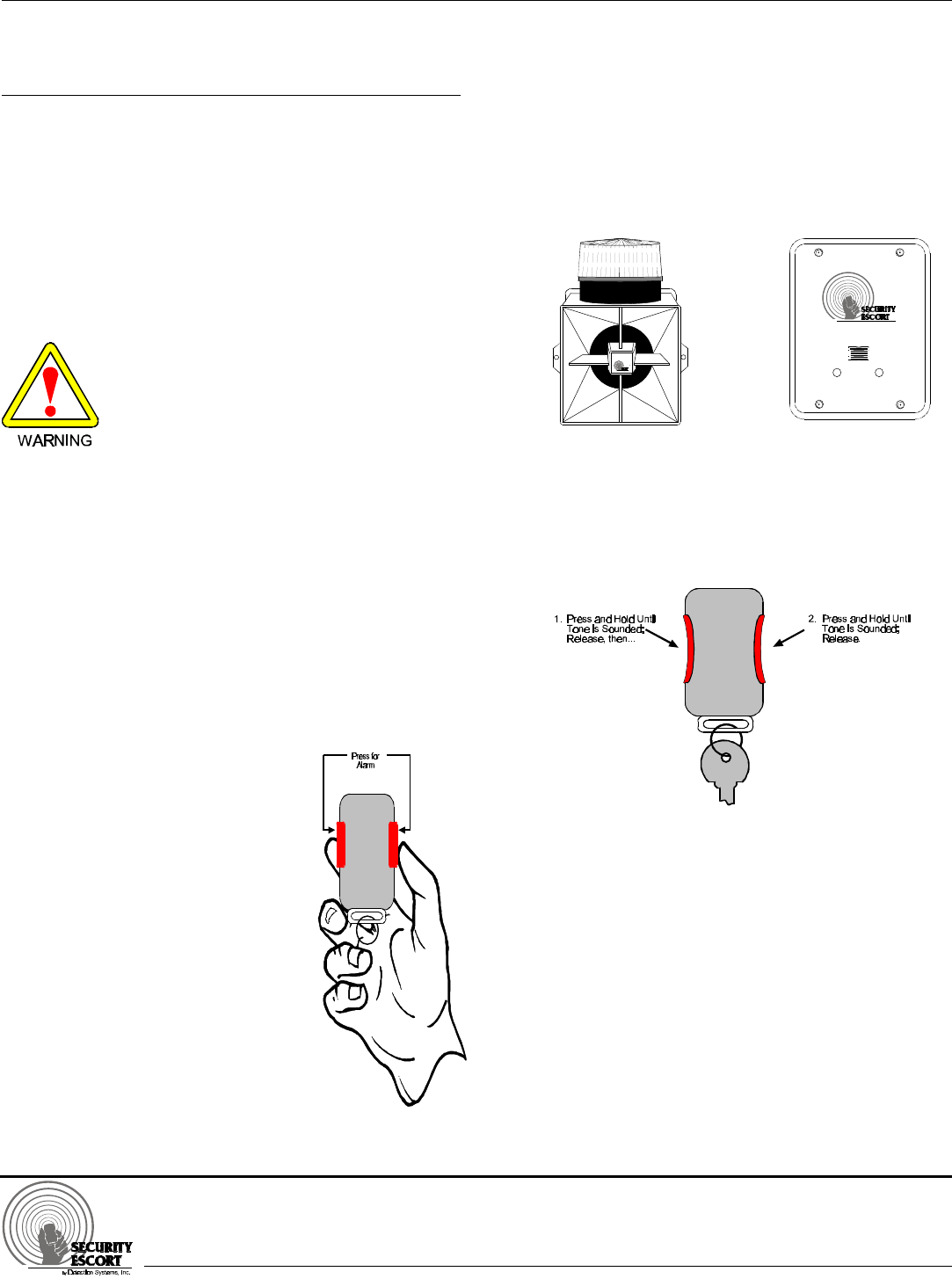Bosch Security Systems 0117-4 Security Escort Transmitter User Manual SE3 S
Bosch Security Systems Inc Security Escort Transmitter SE3 S
manual

Copyright © 1997 - 1998 Detection Systems, Inc. SE3/SE4 Transmitters User’s Guide PN 36447C
9/98
Introduction
The SE3 and SE4 are personal transmitters designed to
work with the Security Escort System. When initiated, a
signal identifying you and your location is sent to the
security office. The SE3 and SE4 may also be tested
within sight of a Receiver or Siren/Strobe by the user.
The SE3 and SE4 are available in two models: User (U)
model and Security (S) model. The User model is the
standard model; the Security model has the same
features as the User model, except that the transmitter will
not make an audible tone when transmitting an alarm.
User’s Guide
for the
SE3/SE4 Security Escort Transmitters
The Security Escort system is NOT a substi-
tute for safe behavior. System users should
not take personal risks under the misconcep-
tion that the system will provide protection
that will compensate for taking such risks.
Figure 2. Siren/Strobe and Receiver
Figure 1.
Transmitting an
Alarm
Transmitting an Alarm
Use your transmitter to transmit an alarm only when you
are in danger, seriously injured, or feel threatened.
NOTE: Your personal transmitter is an emergency communica-
tion device and should not be used for routine commu-
nications with security officials.
Transmitting an alarm alerts a computer located in the
security office that you require emergency assistance. A
display on the computer screen indicates your identity and
approximate location, and an officer is dispatched to
assist you. In some facilities, flashing strobes and
audible sirens will be activated in the vicinity of your
location.
To transmit an alarm:
•Hold the transmitter away from
your body.
•Press both buttons together and
hold!
In a vehicle, hold the transmitter
close to a window when transmit-
ting.
NOTE: You do not have to point the
transmitter at a Receiver, nor do you
need to be in sight of a Receiver to
activate an alarm.
Testing the Transmitter
Test the transmitter weekly. To verify the transmitter’s
operation:
1. Stand in sight of a Security Escort Siren/Strobe or a
Security Escort Receiver. Receivers are located inside
buildings usually within sight of an exit door. They are
mounted on walls in light beige, rectangular enclo-
sures bearing the Security Escort logo. Siren/Strobes
are typically mounted on outside building walls and on
light poles.
2. Press either button on your Security Escort Transmitter
for about one second until you hear a tone. Release.
Then press the other button for about one second until
you hear a tone. Do not hold both buttons down at the
same time as this will generate an alarm.
3. Look for a flashing strobe on a Siren/Strobe or a
flashing green light on a Receiver. A flashing green
light on a Receiver or a flashing strobe on an Siren/
Strobe confirms that the entire system is working. If
you do not see the flashing light or flashing strobe, the
test was not successful.
NOTE: There might be a brief delay of two or three seconds
before the flashing light appears.
If there is no response, try the test again. If there is no
response the second time, your transmitter might not be
working. Take the transmitter to the security office.
Figure 3. Testing the Transmitter
DO NOT HESITATE TO RETRANSMIT.
The system will update your location
each time you retransmit an alarm.
Once initiated, the transmitter will send
a signal every few seconds updating
your location until a test is performed.

PN 36447C 9/98 SE3/SE4 Transmitters User’s Guide Copyright © 1997 - 1998 Detection Systems, Inc.
Page 2
Important Information for all Users of the
Security Escort System
Protected Areas
Check with the security department to verify the exact areas
of the facility that are protected by the system and those
that are not.
Use of Transmitter by Others
Your personal transmitter is assigned specifically to you
and is for your use only. It should not be transferred,
loaned, or shared with another individual. Before letting
anyone handle your transmitter, be sure to inform them
that it is an emergency communication device that, when
activated, transmits your identity. An officer will be dis-
patched to the location of the transmitter when it is
activated.
Lost or Stolen Transmitters
In the event your transmitter is lost or stolen, report the
incident immediately to the security office so that a
replacement can be issued to you and the original
transmitter can be deleted from the system.
Tips for Better Transmission
As with all radio equipment, the signal strength from your
Security Escort Personal Transmitter will be reduced by
metal and wet surfaces, and to some extent by the human
body. To ensure proper transmission of an alarm, hold the
transmitter in one hand, away from your body and other
objects, press both buttons together and hold. In a vehicle,
hold the transmitter close to a window when transmitting.
Do not hesitate to retransmit.
Battery Life
Assuming normal usage (such as weekly testing), the
battery will last approximately four years. If the battery is
weak, a special signal is sent to the security office during a
test. Tests will not produce a flashing light on a Receiver
or Siren/Strobe when your transmitter has a weak battery.
Exposure to Moisture
The transmitter is designed to be water resistant, and
chances are it will not be affected by moisture. Neverthe-
less, you should test your transmitter a few times (several
hours apart) after it has been exposed to moisture to verify
it is working properly.
Accidental Alarms
If you accidentally set off an alarm, STAY WHERE YOU ARE!
Wait for the security official who responds to your alarm.
Explain that you inadvertently set off your transmitter and
make it clear that you are not experiencing an emergency.
FCC Statement
This device complies with Part 15 of the FCC Rules and
with RSS-210 of Industry and Science Canada. Operation
is subject to the following two conditions: (1) this device
may not cause harmful interference, and (2) this device
must accept any interference received including interfer-
ence that may cause undesired operation.
Warranty Disclaimer
Any changes or modifications to the Security Escort
personal transmitter not expressly approved by Detection
Systems, Inc. will void the product warranty.